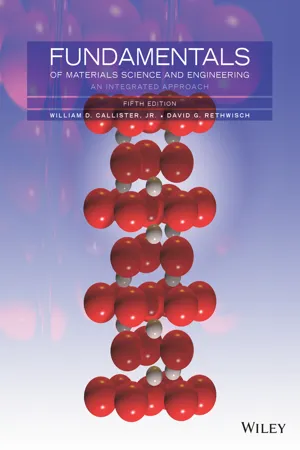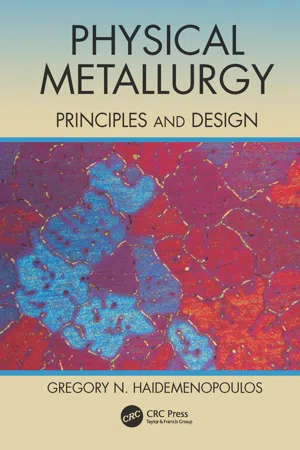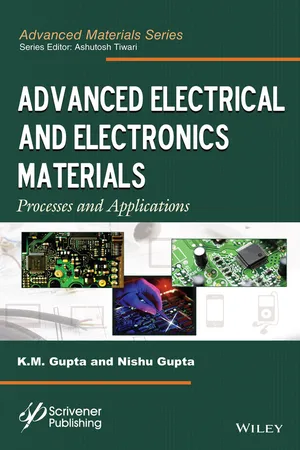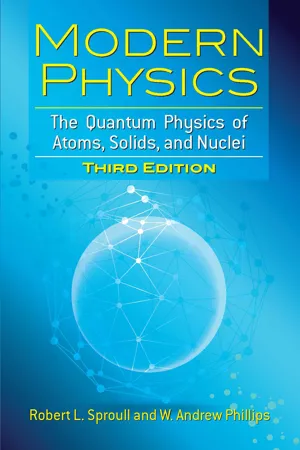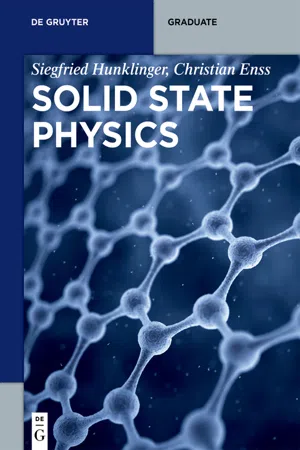Technology & Engineering
Imperfections in Solids
Imperfections in solids refer to defects or irregularities in the arrangement of atoms within a solid material. These imperfections can include vacancies, interstitial atoms, dislocations, and grain boundaries, which can significantly impact the mechanical, electrical, and thermal properties of the material. Understanding and controlling these imperfections is crucial in engineering materials with desired properties for various technological applications.
Written by Perlego with AI-assistance
Related key terms
Related key terms
1 of 4
Related key terms
1 of 3
8 Key excerpts on "Imperfections in Solids"
- eBook - ePub
Fundamentals of Materials Science and Engineering
An Integrated Approach
- William D. Callister, Jr., David G. Rethwisch(Authors)
- 2018(Publication Date)
- Wiley(Publisher)
Section 5.8 contains a detailed description of this process.WHY STUDY Imperfections in Solids?
The properties of some materials are profoundly influenced by the presence of imperfections. Consequently, it is important to have knowledge about the types of imperfections that exist and the roles they play in affecting the behavior of materials. For example, the mechanical properties of pure metals experience significant alterations when the metals are alloyed (i.e., when impurity atoms are added)—for example, brass (70% copper–30% zinc) is much harder and stronger than pure copper (Section 8.10 ).Also, integrated circuit microelectronic devices found in our computers, calculators, and home appliances function because of highly controlled concentrations of specific impurities that are incorporated into small, localized regions of semiconducting materials (Sections 12.11 and 12.15 ).Learning Objectives
After studying this chapter, you should be able to do the following:- Describe both vacancy and self-interstitial crystalline defects.
- Calculate the equilibrium number of vacancies in a material at some specified temperature, given the relevant constants.
- Name and describe eight different ionic point defects that are found in ceramic compounds (including Schottky and Frenkel defects).
- Name the two types of solid solutions and provide a brief written definition and/or schematic sketch of each.
- Given the masses and atomic weights of two or more elements in a metal alloy, calculate the weight percent and atom percent for each element.
- For each of edge, screw, and mixed dislocations:
- describe and make a drawing of the dislocation,
- note the location of the dislocation line, and
- indicate the direction along which the dislocation line extends.
- Describe the atomic structure within the vicinity of (a) a grain boundary and (b) a twin boundary.
5.1 INTRODUCTION
- eBook - ePub
Physical Metallurgy
Principles and Design
- Gregory N. Haidemenopoulos(Author)
- 2018(Publication Date)
- CRC Press(Publisher)
3Structural imperfections
3.1 Introduction
The main characteristic of crystal structure, discussed in the previous chapter, is the periodic arrangement of atoms. However, in a real metal, the crystal structure is not perfect and contains several types of imperfections, which disrupt the periodicity of the crystal. Structural imperfections have a strong influence on physical and mechanical properties of metals as well as on the evolution of phase transformations in metallic materials. Imperfections can be classified according to dimension:- Point defects, such as vacancies and interstitials
- Linear imperfections, such as edge and screw dislocations
- Surface imperfections, such as grain boundaries and interfaces
- Three-dimensional defects, such as voids and inclusions
All the above defects play a key role in the mechanical behavior of metals and the development of microstructure through phase transformations. For example, several phase transformations take place by atomic diffusion, where point defects, such as vacancies are essential. In addition, diffusion can be accelerated by the presence of dislocations or grain boundaries, which act as high diffusivity paths. The plastic deformation of metals takes place by dislocation glide, while strengthening is accomplished by impeding dislocation motion. The most common obstacles to dislocation glide are other dislocations, second phase particles or precipitates and grain boundaries. The three-dimensional imperfections, such as voids and inclusions, play a key role in the ductile fracture of metals. The examples discussed above, highlight the importance of imperfections in the behavior and properties of metals and alloys. The specific structural imperfections will be discussed in the following sections.3.2 Point Defects
3.2.1 Vacancies and Interstitials
In a perfect crystal all lattice sites are occupied by atoms. The two most important point imperfections or defects are, vacancies and interstitials, depicted in Figure 3.1 - eBook - ePub
Advanced Electrical and Electronics Materials
Processes and Applications
- K. M. Gupta, Nishu Gupta, Ashutosh Tiwari(Authors)
- 2015(Publication Date)
- Wiley-Scrivener(Publisher)
real crystals. They are of finite dimensions. They have broken bonds at the boundaries where bonding forces remain unbalanced. Thus the boundary of a crystal is a defect in itself.3.11.1 Disadvantageous Effects of Imperfections
These imperfections lead to several deficiencies in the solids. Solids are generally imperfect. A perfect single crystal is rarely available. Polycrystalline solids are, inevitably, imperfect. We shall deal with all such imperfections (defects) of crystalline solids in this chapter.- Presence of imperfections in crystalline materials is generally undesired.
- They decrease the mechanical strength of materials.
- We have already discussed that a material does not attain its theoretical strength due to presence of imperfections.
3.11.2 Advantageous Effect of Imperfection
Imperfections affect structure-sensitive properties of crystals. Their presence is advantageous in certain applications.- Parts per million (ppm) doping of phosphorus in silicon changes the behaviour of intrinsic semiconductor and makes it suitable for various applications.
3.12 Classification of Imperfections
Imperfections in crystalline solids are classified as follows.S. No. Main types Sub-types 1. Point imperfections (zero-dimensional defects) Vacancy, substitutional impurity, interstitial impurity, frenkel’s defect, schottky’s defect. 2. Line imperfections (1-dimensional defects) Edge dislocation, screw dislocation, mixed dislocation. 3. Surface or planer imperfections (2-dimensional defects) Grain boundary, twin or twinning, low angle boundary, high angle boundary, twist boundary, stacking fault, interphase. 4. Volume imperfections (3-dimensional defects) Pores, foreign particle inclusions, non-compatibility regions, dissimilar natured regions. Point imperfections, line and surface imperfections may occur together in crystals. These defects are not visible to the naked eye. They can be visualized by using X-rays diffraction techniques and microscopes, already described in chapter 1. Imperfections are also classified on the basis of their dimensions, such as given below. - eBook - ePub
Solid State Physics
From the Material Properties of Solids to Nanotechnologies
- David Schmool(Author)
- 2016(Publication Date)
- Mercury Learning and Information(Publisher)
CHAPTER 4IMPERFECTIONS IN CRYSTALLINE ORDER“Even imperfection itself may have its ideal or perfect state.”—Thomas de Quincey“If someone is too perfect they won’t look good. Imperfection is important.”—Eric Cantona4.1 INTRODUCTIONThus far, we have only considered solids as being a perfectly arranged periodic array of atoms. In reality the order in solids is far from perfect. The principal properties of solids does indeed come, for the most part, from this ordered portion of the sample. However, it would be a gross oversight to ignore the effects of imperfections in crystalline order. Of particular importance are mechanical and electronic properties, which are greatly affected by structural disorder. The consideration of perfect order is an important aid to the theoretical modelling of physical properties and conceptualisation of solids. Many would consider this as a first approximation to the understanding of the physical properties of solids. However, as we have stated, we do need to consider the departures from this perfect image of the crystal/solid to gain a fuller insight in to their physical properties.Structural defects in solids can take a number of forms and generally we classify defects as to their dimensionality. That is to say, whether they are 0, 1, 2 or 3 dimensional defects. In the following sections, we will follow more or less this order in our overview of the defects that can occur in real solids. In the first case, zero-dimensional disorder consists of point defects, which pertain to single atomic positions. Following this we have one dimensional disorders, which occur along a crystal direction, and are called disclocations. Two-dimensional disorder is a planar defect, such as a slip plane and even surfaces in a crystal. Finally, a three dimensional defect will be some form of volume imperfection such as granular - eBook - ePub
Modern Physics
The Quantum Physics of Atoms, Solids, and Nuclei: Third Edition
- Robert L. Sproull, W. Andrew Phillips, W. Andrew Phillips(Authors)
- 2015(Publication Date)
- Dover Publications(Publisher)
9Imperfections in Solids
9-1 INTRODUCTION
Some properties of solids are practically the same for perfect crystals as for crystals with small concentrations of chemical impurities or with other deviations from perfection. Examples of such properties are density, heat capacity, and thermal expansion. On the other hand, minute deviations from crystal perfection control many of the properties of solids, such as the strength of metals and the electrical conductivity of semiconductors, and cause interesting phenomena, such as the light emission by insulators. In this chapter we study a few examples of the ways in which imperfections determine the behavior of solids. The analysis in Chapters 7 and 8 provided the basic understanding required to investigate these and many additional imperfection phenomena.Section 9-2 surveys the types of imperfections present in solids. Diffusion is described briefly in Sec. 9-3 . The absorption of light in insulating crystals is considered in Sec. 9-4 , and the change in electrical conductivity produced by this absorption of light is studied in Sec. 9-5 . The emission of light by solids is considered in Sec. 9-6 . The effect of dislocations on the mechanical properties of metals and alloys will be treated in Sec. 9-7 . The physics of solid surfaces is discussed in Sec. 9-8 . The electrical conductivity of semiconductors, another important application of imperfection theory, will be considered in detail in Chapter 10 .9-2 TYPES OF IMPERFECTIONS
In a perfect crystal every atom is in precisely the correct place in the crystal lattice, there are no atoms missing from sites in the lattice, and there are no foreign atoms. Furthermore, if the perfect solid is not a metal, each of the energy bands is either completely empty (no electrons) or completely full - eBook - ePub
- Marc Descamps(Author)
- 2016(Publication Date)
- Wiley-VCH(Publisher)
The presence of crystalline imperfections in a solid may lead both to local changes in topology at the imperfection and to changes in energy due to any strain set up or relieved by the imperfection [23].The chemical potential of a molecule associated with an imperfection will be different from that of a molecule in a perfect lattice. In order to anticipate the role that imperfections will play in the properties of an organic solid, it will be necessary to establish completely their character. Some salient properties of imperfections in general, and point defects, linear (dislocations), and planar defects (e.g., stacking faults), in particular are now given. We also note that the concept of a volume defect might apply where solvent occlusion is also present.Structural imperfections can be classified into three general types based on their geometry: point, line, and planar.- Point Imperfections: In a pure material, there are several types of point defects. Vacancies exist where atoms or molecules are missing from their normal positions in the crystal lattice. Molecules may also occupy non-lattice (interstitial) sites (Figure 3.1 ). At temperatures above 0 K, there is always an equilibrium number of vacancies present in a crystal. This number N is given by No = Ns exp(–ΔG/RT), where N is the number of lattice sites, ΔG is the free energy for formation of a mole of vacancies, R is the gas constant, and T is the absolute temperature. As the temperature increases, the equilibrium number of vacancies also increases. During crystal growth, a number of these defects in excess of the equilibrium number may be introduced through rapidly quenching from high temperatures, through plastic deformation, or through radiation damage.
Schematic of point defects in a simple square lattice of spheres. (a) Interstitial, (b) vacancy, and (c) simultaneous formation of vacancy and interstitial for a salt-like structure with charge balance preserved.Figure 3.1Plastic deformation or irradiation processes also serve to displace species from their normal lattice sites to interstitial sites. Irradiation, for example, produces equal numbers of vacancies and interstitials. Rapid quenching may generate a large number of nonequilibrium point defects, which may not be able to equilibrate because of low mobility. These point imperfections are centers of relatively small elastic strain, but the resulting local dilations and contractions of the crystal lattice may still be sufficient to allow chemical change to occur by bringing molecules close together or by providing the space necessary for molecular motion to occur (Figure 3.2 ). In salts, it is possible to have vacancies on both sublattices, but interstitials will most likely involve the displacement of the smaller ion.Figure 3.2
- eBook - ePub
- Siegfried Hunklinger, Christian Enss(Authors)
- 2022(Publication Date)
- De Gruyter(Publisher)
radiation damage, which plays an important role in reactor technology.5.1.4 Impurities
Real solids inevitably contain impurities. Since these often have a strong influence on the properties of solids, they are often specifically introduced in the context of technical applications. Well-known examples are the refinement of metals and the doping of semiconductors. Depending on size, chemical properties, and temperature, impurities occupy various places in the crystal lattice. As shown in Figure 5.1 , substitutional impurities occupy a regular site whereas interstitial impurities take up positions between the regular lattice sites. There is often a strong interaction between the impurities and the inherent defects of the crystal. For example, large impurities in metals usually surround themselves with vacancies, allowing the reduction of the high elastic stresses in the surroundings.The structure of point defects is usually even more complicated for crystals with a poly-atomic basis. For example, for crystals with a diatomic basis, interchanging neighboring chemically-different atoms effectively results in two regular lattice sites being occupied by “impurities”, although no foreign atoms have been added. This type of defect is of great importance for compound semiconductors because it causes unwanted doping. These so-called “antisite defects” occur particularly frequently when the atoms involved have comparable diameters, as is the case with the semiconductor indium antimonide, for example.5.1.5 Atomic Transport
Individual atoms or ions can move through a solid under external influences such as an electric field or driven by a concentration gradient. The prerequisite for this to happen is almost always the existence of structural defects. Single atoms generally move via jumping in and out of vacancies or via interstitial positions, whereas extended defects such as dislocations (Section 5.2) are required for the motion of larger atomic structures. - eBook - ePub
Metal Oxide Defects
Fundamentals, Design, Development and Applications
- Vijay Kumar, Sudipta Som, Vishal Sharma, Hendrik C. Swart(Authors)
- 2022(Publication Date)
- Elsevier(Publisher)
129 ].Figure 9.4A schematic of (A) an edge dislocation showing a half-plane created in the crystalline structure and the corresponding Burgers vector for edge and perfect crystals and (B) a screw dislocation and its corresponding burgers vector compared to a perfect crystal.The figure is reprinted from Ref. D. Hull, D.J. Bacon, Chapter 1 - defects in crystals, in Introduction to Dislocations, fifth ed., in: D. Hull, D.J. Bacon (Eds.), Butterworth-Heinemann: Oxford. 2011, p. 1–20 after permission.3.2. Effect of defects on the properties of oxide materials
When dealing with defects in MOs, the first phenomenon to consider is diffusion. Diffusion takes place in the presence of vacancies and interstitials point defects, dislocations, and planar defects through the migration of defects in a direction opposite to the vacancy [131 ]. In fact, defects are known as active diffusion paths to facilitate high diffusivity. Morphology of surface, porosity, grain size and distribution, temperature, and the activity of the atoms in the lattice structure are the factors affecting diffusion and consequently affecting transport properties as well as electrical conductivity [131 ]. Defects are usually supposed to deteriorate the properties of nanostructures. However, they can be used to enhance properties too. A recent strategy proposed to alter the electronic properties of some MOs like MnO2 [132 ], TiO2 [133 ], and Bi2 O3 [134 ] is creating oxygen defects on them referred to as surface defect engineering. Research shows that oxygen defects can boost the capacitance of these materials by inducing impurity states in their bandgap, affecting the surface redox reaction, and tuning the donor densities of the oxide material [135 ]. Such enhancements make MOs more suitable for storage applications compared to their counterparts like conductive polymers or carbon-based nanocomposites [135 ]. Moreover, recent advancements reveal that point defects in the form of oxygen vacancies or foreign doped atoms promote the photocatalytic properties of MOs making them appropriate for energy storage and water purification applications [136 ]. The other property influenced by defects is adsorption, which is governed by the electrostatic interactions occurring on their surface [137 ,138 ]. For MOs with their covalent character, adsorption deals with the formation of strong chemical bonds between adsorbent and adsorbate and transferrin charge between them. Real oxides provide a larger variety of binding sites due to having defects on their surfaces [139 ,140 ]. Thus, they offer stronger chemical bonds and higher binding energies suggesting better charge transfer reactions resulting in higher adsorption performance of defective MOs compared to the ideal oxides [139 ,141
Index pages curate the most relevant extracts from our library of academic textbooks. They’ve been created using an in-house natural language model (NLM), each adding context and meaning to key research topics.
Explore more topic indexes
Explore more topic indexes
1 of 6
Explore more topic indexes
1 of 4
